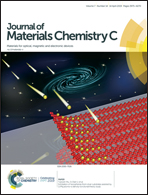Controllable switching properties in an individual CH3NH3PbI3 micro/nanowire-based transistor for gate voltage and illumination dual-driving non-volatile memory
Abstract
Hybrid organic–inorganic perovskite materials have been widely applied in resistive switching (RS) memory device; however, their underlying physical storage mechanism is still a subject of debate. Herein, a field effect transistor (FET) based on an individual CH3NH3PbI3 (MAPbI3) micro/nanowire was successfully constructed. Its conductance can be accurately modulated by gate voltage and visible light, exhibiting a gate voltage and an illumination-controlled non-volatile memory feature. The constructed FET can reversibly transit between high resistance states (HRS) and low resistance states (LRS) by controlling the gate voltage. The non-volatile RS memory effect predominantly originates from the controllable modulation of surface barrier triggered by the injection of holes into/from the traps located in the surface space charge region under the synergy of gate voltage and illumination. For an individual MAPbI3 micro/nanowire-based FET, its tunable electrical properties with non-volatile memory, controlled by gate voltage and illumination via the adjustment of its surface states, suggest that it has a great potential in the application of gate voltage and illumination dual-driving high-performance non-volatile information memory.



 Please wait while we load your content...
Please wait while we load your content...